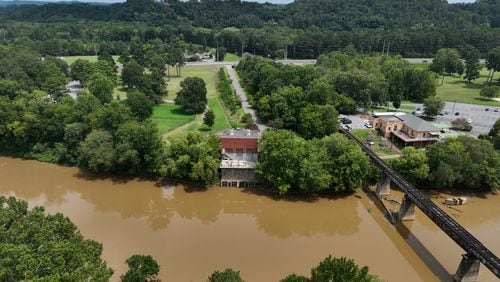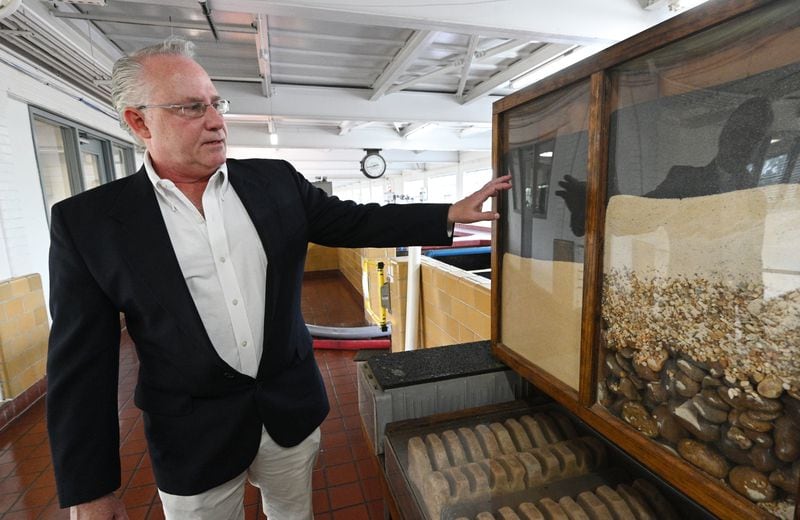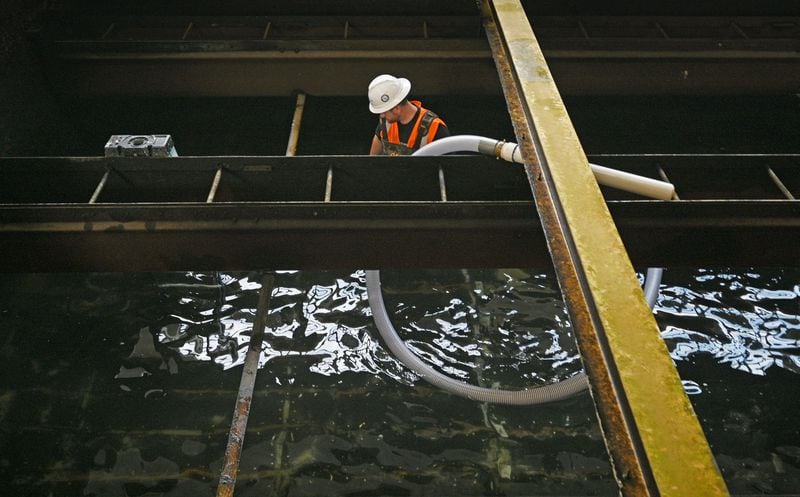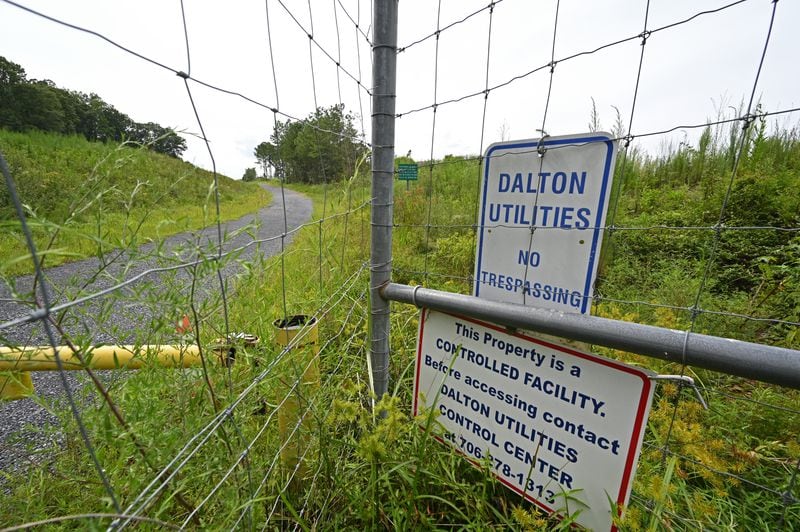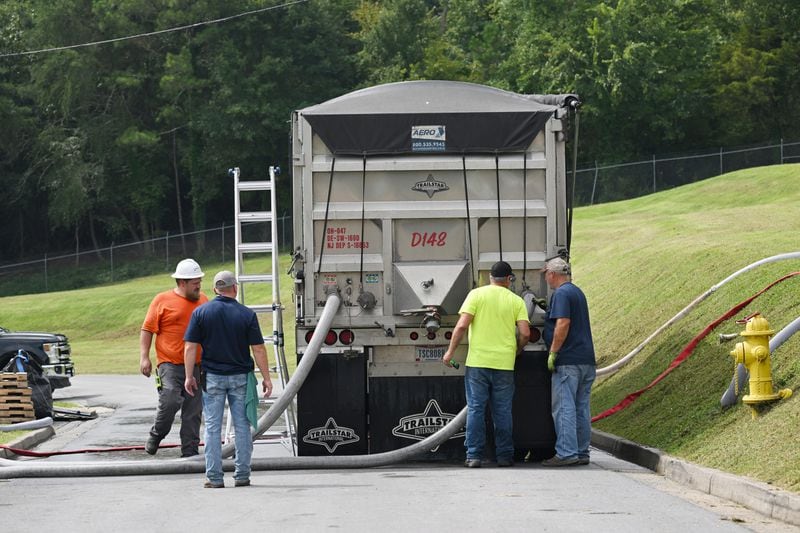Along the banks of the winding Conasauga River in Northwest Georgia lies a tract of rolling hills and dense forest more than 50 times the size of Atlanta’s Piedmont Park.
The 9,600-acre expanse attracts hawks, wild turkey, deer and other wildlife, as well as bird watchers and hunters. This haven is also the site of a complex wastewater treatment system operated by Dalton Utilities, the city of Dalton’s provider of electricity, gas, water and wastewater services.
Beneath the pines and hardwoods of this landscape is an unseen chemical threat to the people and wildlife downstream as the Conasauga flows into the Oostanaula River.
For decades, the Oostanaula, the city of Rome’s main water source, has been contaminated with toxic “forever chemicals” — the tongue-twisting polyfluoroalkyl and perfluoroalkyl substances better known by their acronym, PFAS. The chemicals have long been used in the “carpet capital of the world,” as Dalton is known for its oversized role in supplying the global flooring marketplace.
Since the late 1980s, Dalton Utilities has dispersed a potentially dangerous brew of PFAS-laden effluent through 19,000 sprinkler heads onto the vast acreage along the Conasauga. The utility touts the system — which is permitted to spray an average of 30 million gallons a day — as a “model” of wastewater management that uses soil and plant roots to filter out pollutants.
Separate lawsuits filed by a Rome resident and the city itself allege runoff from Dalton Utilities’ “land application system” — one of the largest forested sprayfield sites in the country — is sending huge amounts of toxic PFAS chemicals into the Conasauga River.
“Forever chemicals” have been used for decades to add oil-, water-, and heat-resistance to dozens of products — from pans and food wrappers to fabric and carpets. But their resistance to breaking down means traces can be found nearly everywhere on Earth.
For decades, companies and facilities linked to the region’s flooring industry have sent their wastewater to Dalton Utilities. But the lawsuits claim its treatment facilities, including the land-spraying operation, do not remove PFAS.
Testing by experts hired by the plaintiffs reveals that staggering concentrations of PFAS have accumulated in the site’s streams and wetlands that connect to the Conasauga. The result is a persistent source of pollutants that continues to foul the waterways that supply drinking water to Rome, the complaints say.
Dalton Utilities spokeswoman Kay Phillips declined to answer questions about the utility’s wastewater treatment practices and the sprayfield site. Instead, she said “DU is involved in active litigation regarding PFAS and will defend those suits vigorously.”
PFAS are found in the blood of most people in the U.S. federal research shows, and the chemicals have been detected in even the most remote corners of the world. A mounting body of evidence has linked exposure to minuscule amounts of the chemicals to an array of illnesses: cancers, immune system suppression, elevated cholesterol and decreased infant and fetal growth.
Earlier this year, amid growing health concerns, federal regulators drastically cut the recommended drinking water levels for two “forever chemicals” to near zero. The moves came after new research showed “... the levels at which negative health effects could occur are much lower than previously understood,” Environmental Protection Agency press secretary Tim Carroll said in a statement.
President Joe Biden’s administration has also made PFAS pollution a priority, funneling $5 billion from the bipartisan infrastructure law to fund water treatment upgrades.
For now, the epicenter of Georgia’s PFAS problem lies in Rome, Summerville and other Northwest Georgia towns. But experts told The Atlanta Journal-Constitution other communities across the country — including Atlanta — could also face water quality issues as PFAS research advances and federal regulations on the chemicals tighten.
“A community that thought they had no problem may actually have a problem — they just haven’t tested for it and found it,” said Mike Hackett, the director of Rome’s water and sewer division.
Credit: HYOSUB SHIN / AJC
Credit: HYOSUB SHIN / AJC
Reinventing Rome’s water system
Hackett said he first realized the threat PFAS posed to the city’s residents in 2016.
That year, the federal EPA dramatically lowered its recommended safe allowance for certain PFAS in drinking water. That meant Rome could no longer rely on the Oostanaula River — which supplied 95% of the city’s water — because its PFAS levels were now too high.
Hackett said the department immediately shut down most of Rome’s water intakes on the Oostanaula and switched to drawing water from a smaller pump station on the Etowah River.
Shifting federal guidance since has forced Rome’s water department to reinvent treatment processes on the fly.
On a recent August morning inside Rome’s Bruce Hamler Water Treatment Facility, a worker in fishing waders vacuumed a fine, black sediment called granular activated carbon out of a water filter bed. The material pulls PFAS chemicals from water and is one temporary measure the city has used to maintain a safe supply.
More expensive, permanent solutions are on the way to meet more stringent federal health guidance, Hackett said.
Credit: HYOSUB SHIN / AJC
Credit: HYOSUB SHIN / AJC
‘Major deficiencies’
The two lawsuits filed over the PFAS in Rome’s water make similar claims and include many of the same defendants.
Both complaints name the chemical conglomerates 3M and E.I. duPont de Nemours and Company (DuPont), alleging the companies knew for years that PFAS posed serious risks to human health and the environment. Chemical manufacturers Daikin America and Chemours, which assumed DuPont’s chemical business after a 2015 spinoff, are also named defendants.
PFAS produced by those companies have been used for years by Dalton’s largest flooring manufacturers, including Shaw Industries, Mohawk Industries and others, the lawsuits claim. Those companies pipe their wastewater to Dalton Utilities’ wastewater treatment plants, before the effluent is pumped to be sprayed on the land application site.
Credit: ArLuther Lee
Credit: ArLuther Lee
Testing last year by plaintiffs’ experts found combined PFAS concentrations in several of the site’s streams ranging from 1,640 to 38,700 parts per trillion. In a wetland area connected to the river by streams, PFAS levels topped 180,000 parts per trillion.
3M spokesman Sean Lynch said his company acted responsibly and “will vigorously defend its record of environmental stewardship.” Lynch added that 3M has taken steps to reduce chemical discharges from its facilities.
Representatives from Daikin, Chemours, Shaw and Mohawk did not respond to requests for comment.
Dalton Utilities’ site has come under scrutiny before for its wastewater handling. In 2001, federal and state regulators found “major deficiencies” on the sprayfield site and other treatment facilities were resulting in illegal discharges to the Conasauga River. The utility paid a $6 million penalty to Georgia’s Environmental Protection Division and the EPA and was required to make upgrades to comply with the federal Clean Water Act.
The Rome lawsuits claim breaches at the upriver site are still occurring, violating the Clean Water Act and overstepping the terms of the permits granted by state regulators.
A 2015 permit allows Dalton Utilities to operate the sprinkler system but does not allow pollutants to be discharged directly into surface waters, according to EPD spokeswoman Sara Lips. Lips said the permit does not require PFAS monitoring.
Credit: HYOSUB SHIN / AJC
Credit: HYOSUB SHIN / AJC
Pocketbooks pay the price in Rome
Not only are PFAS a health concern for Rome’s residents — they’re a financial burden.
Earlier this year, Rome’s city commission approved water rate hikes of 9% for each of the next four years. After that, customer bills will climb 3% annually for six more years. The increases mean the average Rome household with a $60 water bill today could pay $101 each month by 2031.
Rome officials said the increased rates are needed to pay for a permanent solution to its pollution problem — a new, $100 million reverse-osmosis water treatment plant expected to open in 2025.
The technology is costly and more energy intensive to operate than a conventional plant. However, it should remove nearly all PFAS from Rome’s drinking water, allowing the city to resume drawing most of its supply from the Oostanaula River, Hackett said.
In the meantime, Rome’s residents are already paying for the plant after rate hikes kicked in this past March.
Sunny Knauss, owner of Sunflour Community Bakery, said her business has “felt the pinch,” on top of other rising costs from inflation and supply chain issues.
Knauss said she understands why the city commission raised rates, but wants polluters to pay to clean up the mess.
If Rome’s lawyers are successful in court, they will.
The city’s lawsuit against Dalton Utilities and the other defendants, filed in Floyd County Superior Court, is seeking $352 million to cover the cost of its new water treatment plant, plus damages.
The city is also asking the court to order the defendants to clean up the sprayfields upstream. An expert enlisted by the city estimated remediating the site could cost $850 million and take 30 years to complete.
Andy Davis, attorney for Rome and his co-counsel, Jeff Friedman, said in a statement that they believe the lawsuit ”will hold the polluters responsible, make them clean up their mess and pay for the water purification system that we desperately need to provide safe drinking water.”
Rome resident Jarrod Johnson, suing in U.S. District Court in Georgia’s Northern District, is seeking class-action certification with other Rome water customers. That case is also seeking to force the defendants to clean up the Dalton Utilities site, and recoup the $94 million Rome’s residents face in increased water bills. An attorney for Johnson declined comment.
This week, Dalton-based chemical manufacturer Polyventive LLC agreed to a settlement with Johnson that would bar the company from selling PFAS to Dalton’s flooring industry and from discharging contaminated wastewater into Dalton Utilities’ system. It also agreed to pay $75,000 to fund water quality improvement projects in the area and cover plaintiffs’ legal fees, in exchange for releasing Polyventive from further legal exposure.
The company joins a handful of other smaller defendants in the case that have reached settlements.
Credit: HYOSUB SHIN / AJC
Credit: HYOSUB SHIN / AJC
‘They’ll run into the same problems we did’
Rome’s case is set to go to trial next June. In the coming months, the regulatory landscape could change again.
Drinking water health advisories issued by the EPA for PFAS offer guidance to utilities, but are not legally enforceable.
Later this year, the agency is expected to propose a national drinking water standard for perfluorooctane sulfonic acid (PFOS) and perfluorooctanoic acid (PFOA), the two most-studied “forever chemicals” linked to a host of health conditions. Manufacturers have phased out those two chemicals, but decades of use mean they persist in the environment.
If the rule is finalized by the end of 2023, as planned, it would set enforceable limits that utilities across the country will need to meet. Federal regulators are also assessing the toxicity of five other PFAS chemicals, with more likely to be investigated in the future, EPA press secretary Tim Carroll said.
While the new standards are being developed, Georgia EPD is assessing PFAS contamination in the state’s drinking water.
In Phase 1 testing last winter, state regulators required all drinking water systems across a wide swath of Northwest Georgia serving more than 500 customers to test treated drinking water for PFAS. The sampling focused on the region because of its history of contamination.
The results turned up several utilities with PFAS concentrations above the latest federal health advisory levels, including in Rome, Dalton, Calhoun, Chatsworth and Summerville.
Phase 2 of EPD’s testing began this summer. This time, the agency is prioritizing large public water systems serving more than 100,000 people.
Many of the state’s largest water providers — including the city of Atlanta — have not reported their results.
EPD says it hopes to have Phase 2 testing complete by the end of this year.
Ultimately, the extent of the problems facing other Georgia cities depends on what testing reveals, as well as where federal regulators choose to set new drinking water standards. If the federal government’s recent moves are any indication, Hackett expects other utilities could soon face a PFAS reckoning.
“If the amount allowable is 4 or 2 parts per trillion, they don’t really have any choice,” Hackett said. “They’ll run into the same problems we did.”
- Spencer Donovan contributed to this report.
About the Author
